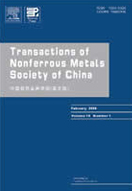Influence of anodization conditions on deposition of hydroxyapatite on α/β Ti alloys for osseointegration: Atomic force microscopy analysis
(1. Faculty of Engineering, Modern University for Technology and Information (MTI), Cairo 11585, Egypt;
2. Restorative and Dental Materials Department, National Research Centre, Giza 12622, Egypt;
3. Chemistry Department, Faculty of Science, Cairo University, Giza 12613, Egypt;
4 Central Metallurgical Research and Development Institute, CMRDI, P.O. 87, Helwan 11421, Egypt)
2. Restorative and Dental Materials Department, National Research Centre, Giza 12622, Egypt;
3. Chemistry Department, Faculty of Science, Cairo University, Giza 12613, Egypt;
4 Central Metallurgical Research and Development Institute, CMRDI, P.O. 87, Helwan 11421, Egypt)
Abstract: Integrating titanium-based implants with the surrounding bone tissue remains challenging. This study aims to explore the impact of different anodization voltages (20-80 V) on the surface topography of two-phase (α/β) Ti alloys and to produce TiO2 films with enhanced bone formation abilities. Scanning electron microscopy coupled with energy dispersive spectroscopy (SEM-EDS) and atomic force microscopy (AFM) were applied to investigate the morphological, chemical, and surface topography of the prepared alloys and to confirm the growth of hydroxyapatite (HA) on their surfaces. Results disclosed that the surface roughness of TiO2 films formed on Ti-6Al-7Nb alloys was superior to that of Ti-6Al-4V alloys. Ti-6Al-7Nb alloy anodized at 80 V had the highest yields of HA after immersion in simulated body fluid with enhanced HA surface coverage. The developed HA layer had a mean thickness of (128.38±18.13) μm, suggesting its potential use as an orthopedic implantable material due to its promising bone integration and, hence, remarkable stability inside the human body.
Key words: material science; electrochemical anodization process; atomic force microscopy; α/β Ti alloys; hydroxyapatite deposition

